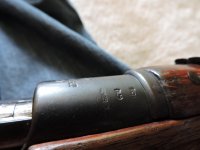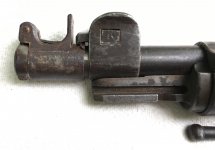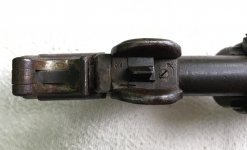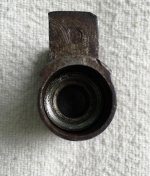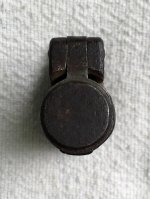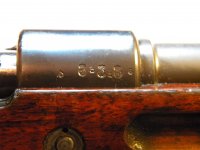You are using an out of date browser. It may not display this or other websites correctly.
You should upgrade or use an alternative browser.
You should upgrade or use an alternative browser.
Kar 98AZ 1917 1294
- Thread starter Ghostrider5211
- Start date
Ghostrider5211
Active member
Any numbers or letters on the buttplate?
Yes. Below the lower screw that holds the buttplate onto the stock it is stamped 1294.
Ghostrider5211
Active member
That's not a correct muzzle cap(which doesn't affect the gun), the lower band is on backwards, and the sight slider is wrong, too. Other than that, it's a nice rifle.
Yeah. Turns out the sight slider looks to be from a Mosin Nagant!! O_O What will it take to repair that? The lower barrel band will be turned around to the correct side once I get it to the new house.
mauser1908
Senior Member
Yes. Below the lower screw that holds the buttplate onto the stock it is stamped 1294.
Anything other than the serial number? If it was a war-time rework it was done lower than the depot level. Depot reworks will have a number representing the depot and a letter representing the armorer that did the work.
Ghostrider5211
Active member
Anything other than the serial number? If it was a war-time rework it was done lower than the depot level. Depot reworks will have a number representing the depot and a letter representing the armorer that did the work.
No letter anywhere. Number only.
PrayingMantis
Senior Member
That is a good thought, Sam. I have seen at least a couple Gew 88s that went through a depot with full serial numbers on bands. This Kar looks like it avoided a depot though. Ghostrider, could you do a picture of the right receiver? If it has qualifiers then it's definitely a post war rework.
Ghostrider5211
Active member
That is a good thought, Sam. I have seen at least a couple Gew 88s that went through a depot with full serial numbers on bands. This Kar looks like it avoided a depot though. Ghostrider, could you do a picture of the right receiver? If it has qualifiers then it's definitely a post war rework.
What is a qualifier?
Attachments
PrayingMantis
Senior Member
I might be using the wrong terminology, I think qualifier applies to extra marks below the acceptance in Danzig Gews. What I mean are the numbers applied in between the acceptance on weapons reworked in the postwar era. Attached is a photo of my S28 with rework numbers added.
Also attached are pictures of a Kar98 muzzle cover.
Also attached are pictures of a Kar98 muzzle cover.
Attachments
Perhaps if you check a couple things we can determine whether this rifle is Imperial or interwar. Is the follower blued, does it stop the bolt on empty? It is rare for an interwar 98a not to have follower modifications. It is the first thing to look for, - that the first two digits are on the bands and stacking hook is also an excellent sign of postwar service. Odds are good this served Germany between the wars. The handguard looks Polish to me, an examination of the internal serial would tell if it is original or not, also taking the handguard off would reveal if it has been re-barreled, which is uncommon, even for interwar rifles.
Ghostrider5211
Active member
Perhaps if you check a couple things we can determine whether this rifle is Imperial or interwar. Is the follower blued, does it stop the bolt on empty? It is rare for an interwar 98a not to have follower modifications. It is the first thing to look for, - that the first two digits are on the bands and stacking hook is also an excellent sign of postwar service. Odds are good this served Germany between the wars. The handguard looks Polish to me, an examination of the internal serial would tell if it is original or not, also taking the handguard off would reveal if it has been re-barreled, which is uncommon, even for interwar rifles.
The follower is blued and stops the bolt on empty, by my recollection. I have yet to take the rifle apart... workbench is being moved at this time. I will try to get those details as soon as possible. I'm learning a very good bit from all of you here.
It is an interwar 98a, those are sure signs of it.. next, at your leisure, take the handguard off and examine the serial number. Incredibly unlikely this is the original HG, but also look at the barrel, typically they are original to manufacture, it is rare to encounter a re-barreled 98a, but they do show up from the interwar period. Typically when they are seen they are recycled 98a barrels or ordnance spares, as I do not believe they made 98a barrels in the interwar period, though they might have made a few very early. You can find them with Weimar eagles and interwar markings, including police acceptance, but again quite rare.
Anyway, while it is a general rule that interwar reworks take a hit on value, it is less so with 98a carbines, especially so with one such as yours where the signs are subtle.
** I would also suggest you examine the stock closely for small acceptance stamps, especially at the wrist and all around the buttstock. If you are lucky, it will have an interwar depot marking, that would help value a little. People like certainty, and things like acceptance are a plus. I assume the buttplate has no other markings, or you'd of shown them, but take some time to examine every surface of the stock for stray or unusual markings. You seem to have had a little bit of luck on this one, VERY often the depots sanded the stocks and often replaced parts, this rifle looks fairly original, with only minimal work done, the follower (which is almost universal, I have never seen an interwar G98 or 98a without a blued-notched follower, but I have seen rifles without the extra band serialing, though rare) and bands look like the extent of the work done. Of course there is the RS part replaced, the m/m bolt, possibly the HG, but the thing with interwar rifles like this is "most" are a lot worse off. It is pretty difficult to find a fully matching interwar rifle, especially G98's...
Anyway, while it is a general rule that interwar reworks take a hit on value, it is less so with 98a carbines, especially so with one such as yours where the signs are subtle.
** I would also suggest you examine the stock closely for small acceptance stamps, especially at the wrist and all around the buttstock. If you are lucky, it will have an interwar depot marking, that would help value a little. People like certainty, and things like acceptance are a plus. I assume the buttplate has no other markings, or you'd of shown them, but take some time to examine every surface of the stock for stray or unusual markings. You seem to have had a little bit of luck on this one, VERY often the depots sanded the stocks and often replaced parts, this rifle looks fairly original, with only minimal work done, the follower (which is almost universal, I have never seen an interwar G98 or 98a without a blued-notched follower, but I have seen rifles without the extra band serialing, though rare) and bands look like the extent of the work done. Of course there is the RS part replaced, the m/m bolt, possibly the HG, but the thing with interwar rifles like this is "most" are a lot worse off. It is pretty difficult to find a fully matching interwar rifle, especially G98's...
Last edited:
Ghostrider5211
Active member
It is an interwar 98a, those are sure signs of it.. next, at your leisure, take the handguard off and examine the serial number. Incredibly unlikely this is the original HG, but also look at the barrel, typically they are original to manufacture, it is rare to encounter a re-barreled 98a, but they do show up from the interwar period. Typically when they are seen they are recycled 98a barrels or ordnance spares, as I do not believe they made 98a barrels in the interwar period, though they might have made a few very early. You can find them with Weimar eagles and interwar markings, including police acceptance, but again quite rare.
Anyway, while it is a general rule that interwar reworks take a hit on value, it is less so with 98a carbines, especially so with one such as yours where the signs are subtle.
If I do discover that the weapon was rebarreled, is that going to affect the shootability? It has a very nice bore. So am I looking at a rifle built during WW1 and then saw interwar service, or am I looking at a interwar built rifle using a 1917 receiver?
No, on the unlikely event of a re-barrel, it will have no influence on its shootability, - from that single reason. It could have other issues that make shooting unsafe (unlikely too) In my experience, it is very rare for a German military rifle that has not seen postwar service in some backward country, like China, Turkey or some Balkan cesspool, to be so worn out to make it unsafe. It is always a good idea to examine the rifle closely, look for breech alterations, bore problems, bulges, check head space with a field gage, but to be honest I have never seen or experienced the slightest problem with a decent rifle using quality ammo.
I should also say though that if you are unsure, have it checked out, - their are no Mulligans on something like this. You can't replace your eyes of fingers.. but the risks of a re-barrel are no greater than the original barrel. The depots did not do shoddy work, especially in the interwar period. Obviously, no one on the forum can give you advise as to the safety of your rifle...
I should also say though that if you are unsure, have it checked out, - their are no Mulligans on something like this. You can't replace your eyes of fingers.. but the risks of a re-barrel are no greater than the original barrel. The depots did not do shoddy work, especially in the interwar period. Obviously, no one on the forum can give you advise as to the safety of your rifle...
If I do discover that the weapon was rebarreled, is that going to affect the shootability? It has a very nice bore. So am I looking at a rifle built during WW1 and then saw interwar service, or am I looking at a interwar built rifle using a 1917 receiver?
The former, this rifle was built and used in WWI, - it is not an interwar build using a salvaged or new made receiver. Really, just going over possibilities, I see nothing to suggest a bad rifle... it is unlikely the barrel was replaced. Most of these rifles ended up with police or training units. The training units rode them hard, this doesn't appear to be such a rifle. Police are very often unit marked, but not always, they can be rough, but most are in excellent condition, though often thoroughly reworked.
So am I looking at a rifle built during WW1 and then saw interwar service, or am I looking at a interwar built rifle using a 1917 receiver?
Not in my opinion. All the 1920 stamp indicated was that the firearm remained in official government inventory following WWI. Most of the German firearms from the war and before, that I have owned haven't had the added 1920 proof. Many 98AZs that I have had and were GI bringbacks from WWII weren't stamped 1920, so it's a matter of conjecture as to where they were stored. We do know that many WWI firearms were kept in police armories and eventually issued to the troops during the emergency in the summer of 1944. When the Treaty of Versailles was in effect, it was closely monitored during the early years and both local authorities and the military were caught hiding all sorts of weaponry in police armories, including airplanes. I suspect that there was much that wasn't discovered, perhaps even your rifle.
This is correct, I agree with this... There were large numbers of "black rifles" (unofficial) in interwar Germany, there were also large numbers held (illegally) by the various paramilitary groups.
Not in my opinion. All the 1920 stamp indicated was that the firearm remained in official government inventory following WWI. Most of the German firearms from the war and before, that I have owned haven't had the added 1920 proof. Many 98AZs that I have had and were GI bringbacks from WWII weren't stamped 1920, so it's a matter of conjecture as to where they were stored..
Warrior1354
ax - hole
Not too mention how many were found in people houses hiding in their walls. Wasn't too long ago we saw something posted here about that. A German house owner found a Gew98 in one of his walls when he was remodeling his home. Believe he turn it in and it got destroyed from what I believe.
k98az
i just bought a nice non matching erfurt 1914 and it was the first one i had ever seen and when they auctioned the real estate off it and 4 other rifles were found in the attic and these people had lived there for 55 years and all they could say was well they have been there at least 55 years
i just bought a nice non matching erfurt 1914 and it was the first one i had ever seen and when they auctioned the real estate off it and 4 other rifles were found in the attic and these people had lived there for 55 years and all they could say was well they have been there at least 55 years


